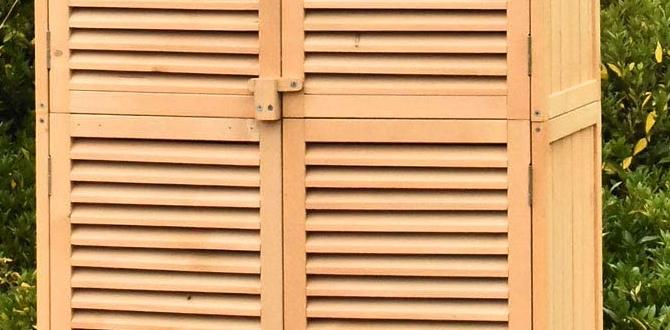Build your own DIY rain barrel system to capture free, nutrient-rich rainwater for your garden. This essential blueprint guides beginners through setting up a sustainable water source, reducing water bills, and helping the environment with simple, step-by-step instructions.
DIY Rain Barrel System: Your Essential Blueprint for Sustainable Watering
Watering our gardens is essential, but those water bills can add up! And sometimes, the tap water just doesn’t seem to make our plants as happy as we’d like. What if there was a way to get free, high-quality water straight from the sky? That’s where a DIY rain barrel system comes in! It’s a super simple, eco-friendly way to give your plants the best. Many gardeners feel a bit daunted by setting one up, but trust me, it’s easier than you think. We’ll walk through everything you need to know, step by step, so you can start collecting rainwater and watch your garden flourish without the extra cost.
This guide will cover all the basics, from choosing the right barrel to setting it up safely and effectively. Get ready to transform your watering routine!
Why Build a Rain Barrel System? The Perks Are Plentiful!
Before we dive into the “how-to,” let’s talk about why this project is so rewarding. A rain barrel isn’t just a quirky garden addition; it’s a smart, sustainable choice for any gardener.
- Saves Money: The most obvious benefit is a lower water bill. Why pay for water when nature provides it for free?
- Healthier Plants: Rainwater is naturally soft and free of the chlorine and minerals often found in tap water, which can be harsh on plant roots. Many gardeners swear by rainwater for lusher growth and healthier foliage.
- Environmental Friendliness: By collecting rainwater, you reduce the demand on municipal water supplies, which is especially important during dry spells. It also helps reduce stormwater runoff, which can carry pollutants into our rivers and streams.
- Reduces Stormwater Runoff: When rain falls on hard surfaces like roofs, it picks up pollutants and rushes into storm drains. A rain barrel intercepts this water, slowing it down and reducing pollution.
- Convenience: Having a water source right in your garden means less lugging of heavy watering cans from the house.
Ready to get started? Let’s break down what you’ll need.
Gathering Your Rain Barrel System Supplies
Setting up a rain barrel system is a straightforward DIY project. You don’t need to be a master builder, just someone willing to follow a few simple steps. Here’s a list of the essential components and tools:
Essential Components:
- The Barrel: This is the heart of your system. You can find food-grade plastic barrels (often 55-gallon drums) from dairy farms, food processing plants, or online suppliers. Make sure it’s clean and hasn’t stored hazardous chemicals. Many garden centers also sell purpose-built rain barrels.
- Spigot/Faucet: A simple brass or plastic spigot that you can connect a garden hose to.
- Hose Connector/Adapter: To attach your hose to the spigot.
- Overflow Hose/Pipe: Essential for directing excess water away from your barrel when it’s full to prevent flooding around your foundation.
- Screen Mesh: To cover the top opening and inlet to prevent mosquitoes and debris from entering.
- Optional: Diverter Kit: Some systems use a diverter that attaches to your downspout, directing water into the barrel and then allowing excess to continue down the downspout. This can be simpler than a direct overflow setup.
- Optional: Foundation/Blocks: To elevate the barrel. This makes it easier to access the spigot with a watering can or hose and increases water pressure.
Tools You’ll Need:
- Drill with various drill bits (including a hole saw bit for the spigot and overflow)
- Measuring tape
- Marker or pencil
- Wrench or pliers (depending on spigot type)
- Safety glasses
- Gloves
- Utility knife or hacksaw (if modifying barrel or downspout)
- Silicone sealant or plumber’s tape (for a watertight seal on the spigot)
Step-by-Step: Building Your DIY Rain Barrel System
Now for the fun part! Let’s get your rain barrel system built and ready to collect precious rainwater. We’ll focus on a common DIY method using a repurposed barrel. If you’re using a kit, always follow the manufacturer’s instructions, but the principles will be similar.
Step 1: Prepare Your Barrel
First, give your barrel a thorough cleaning, especially if it’s a repurposed one. Rinse it out several times with soap and water to remove any residue. Ensure it’s completely dry before proceeding.
Step 2: Install the Spigot
Decide where you want your spigot. It should be positioned a few inches from the bottom of the barrel to allow for easy access with a watering can or hose, but not so low that it won’t capture most of the water.
Using your drill and appropriate hole saw bit (usually around 3/4 inch or 1 inch), drill a hole for the spigot. Make sure the hole is clean and smooth.
Insert the spigot through the hole. You might need a bulkhead fitting or a simple threaded connector depending on your spigot. Apply silicone sealant or plumber’s tape to the threads to ensure a watertight seal. Tighten it securely with a wrench or pliers.
Step 3: Create an Overflow Outlet
This is a critical step for safety and preventing water damage. You need a way for excess water to escape when the barrel is full.
Drill a hole near the top of the barrel, slightly below the rim. This hole should be slightly larger than the diameter of your overflow hose or pipe. Attach a hose fitting or simply insert the end of a flexible hose. You can also use a bulkhead fitting. Secure it with sealant if needed.
Plan to direct this overflow hose away from your home’s foundation, perhaps towards a garden bed or a designated drainage area. A diverter kit can simplify this by managing the overflow directly through the downspout. For more information on managing stormwater, the EPA provides excellent resources on stormwater management.
Step 4: Add a Mosquito-Proof Screen
Mosquitoes love stagnant water! To prevent them from breeding in your rain barrel, you need to block the opening.
If your barrel has a removable lid, you can cut a hole in it slightly smaller than the barrel’s opening, and then fit a sturdy screen mesh over it before replacing the lid. Ensure it is secured tightly. If your barrel has a fixed top with an opening, cut a piece of screen mesh that is larger than the opening and secure it firmly around the edges with tape, glue, or small screws. This prevents debris from entering and filters the water.
Step 5: Position and Connect Your Barrel
Choose a location for your rain barrel near a downspout. It’s ideal to place it on a level, stable surface. Elevating the barrel on cinder blocks or a sturdy stand is highly recommended. This gives the water a bit more gravity-fed pressure when you use the spigot and makes it easier to fill watering cans.
Position the barrel so the top of the barrel is below the point where the downspout attaches to your house. You might need to cut your downspout slightly or use an elbow fitting to direct the flow into the barrel’s screened top.
If using a diverter kit, follow its specific installation instructions, which typically involve cutting a section out of your downspout and fitting the diverter in its place, connecting to the barrel.
Step 6: The First Rain!
Once everything is in place, your DIY rain barrel system is ready! Wait for the next rainfall. Check for any leaks around the spigot and overflow. If you find any, tighten the fittings or add more sealant.
Rain Barrel System Layouts and Options
Not all rain barrel systems are created equal! Depending on your space, needs, and budget, you can choose different configurations. Here are a few popular options:
Single Barrel System
This is the most basic setup, using one barrel. It’s perfect for small gardens or beginners. Water collects in the single barrel, and you access it via the spigot.
Linked Barrel System
If one barrel isn’t enough, you can link multiple barrels together. This is done by drilling a hole near the bottom of the first barrel and installing a connector hose or pipe that leads to a similar opening in the second barrel. The overflow from the last barrel then directs excess water away. This system increases your water storage capacity significantly.
First-Flush Diverter System
A first-flush diverter is a clever add-on. The first few gallons of rain running off your roof contain the most accumulated debris and contaminants from the roof surface. A first-flush diverter automatically diverts this initial, dirtier water away from your barrel. Once a certain volume has passed, it then directs the cleaner water into the barrel. This results in higher-quality stored water. You can purchase these as part of a kit or build a DIY version.
Container Gardening Specifics
For those with container gardens or balconies, a smaller rain barrel might be more suitable. Look for smaller, stackable rain barrels or even food-grade storage totes with spigots. Ensure they are UV-stable and food-grade. The principles of installation remain the same, but the scale is more manageable.
Maintenance: Keeping Your Rain Barrel in Top Shape
A little bit of regular maintenance ensures your rain barrel works efficiently and safely for years to come. Here’s what you need to know:
- Regular Cleaning: Periodically check and clean the screen mesh on top to remove leaves and debris. Rinse the inside of the barrel annually to remove any accumulated sediment.
- Winterizing: In colder climates, you must winterize your rain barrel to prevent freezing and cracking. Empty the barrel completely, disconnect it from the downspout, and store it indoors or upside down. You can also simply disconnect the hose and let any residual water drain.
- Check for Leaks: Periodically inspect the spigot and overflow connections for leaks. Tighten as needed or reapply sealant.
- Inspect for Algae/Mosquitoes: If you notice algae growth (a greenish hue), it might mean light is getting into the barrel. Ensure the lid is secure and opaque. If you suspect mosquito larvae, a few drops of vegetable oil can suffocate them, or you can use specific mosquito dunks approved for water collection. The CDC offers great advice on mosquito control.
Pros and Cons: Is a Rain Barrel Right for You?
Like any garden solution, rain barrels have their advantages and disadvantages. Weighing these will help you decide if this DIY project aligns with your gardening goals and lifestyle.
| Pros | Cons |
|---|---|
| Free, natural water source | Initial setup cost and effort |
| Reduces water bills | Dependent on rainfall (not a constant supply) |
| Healthier for plants (no chlorine/minerals) | Requires space for barrel placement |
| Environmentally friendly | Maintenance required (cleaning, winterizing) |
| Reduces stormwater runoff | Potential for mosquito breeding if not properly screened |
| Can increase water pressure with elevation | Water may contain roof debris if not filtered well |
Frequently Asked Questions About DIY Rain Barrels
Got questions? We’ve got answers! Here are some common queries beginner gardeners have about setting up and using rain barrels.
Q1: How much rain do I need to fill a 55-gallon barrel?
A: It depends on your roof size and rainfall intensity. A 1-inch rainfall on a 1,000 sq ft roof can yield over 600 gallons of water! For a typical single-family home roof, even moderate rain can fill a 55-gallon barrel relatively quickly.
Q2: Can I drink water from a rain barrel?
A: No, rain barrel water is generally not safe for drinking. It can pick up contaminants from your roof and is not treated. It’s best used for watering plants, washing cars, or other outdoor tasks.
Q3: How do I prevent my rain barrel from freezing in winter?
A: In freezing climates, it’s crucial to empty your rain barrel completely before winter. Disconnect it from the downspout and either store it indoors or turn it upside down to prevent water from collecting and expanding.
Q4: Can I use any old plastic barrel?
A: It’s highly recommended to use food-grade barrels (often marked with “food grade” or previously used for products like oils, syrups, or juices). Avoid barrels that held harsh chemicals, pesticides, or anything potentially toxic, as these residues can be harmful to your garden and plants.
Q5: Is a rain barrel legal in my area?
A: In most places, rain barrels are legal and even encouraged. However, some areas or homeowner associations might have restrictions. It’s always a good idea to check with your local authorities or HOA before installing one.
Q6: What’s the best way to connect a rain barrel to my downspout?
A: The most common methods are direct connection (cutting the downspout and directing it into the barrel’s screened opening) or using a downspout diverter kit. Diverters are often preferred as they can manage overflow more effectively and are easier to install for many people.
Q7: My rain barrel seems to be getting slimy. What’s going on?
A: This is likely algae growth, which thrives in sunlight and stagnant water. Ensure your barrel is opaque and that the lid is tightly sealed to prevent light entry. A clean-out once a year will also help manage any buildup.
Conclusion: Your Greener Garden Awaits!
Building a DIY rain barrel system is more than just a gardening project; it’s a step towards a more sustainable lifestyle. By harnessing the power of nature’s free resource, you’re not only saving money and giving your plants the happiest, healthiest water, but you’re also doing your part for the environment.
This blueprint has hopefully demystified the process, showing you that setting up your own rain barrel is achievable and incredibly rewarding. From preparing your barrel and installing the essential components to choosing the right system layout and performing simple maintenance, you’re now equipped with the knowledge to start collecting rainwater.
So, gather your supplies, get a little hands-on, and prepare to enjoy the benefits of your very own DIY rain barrel system. Happy collecting, and even happier gardening!




